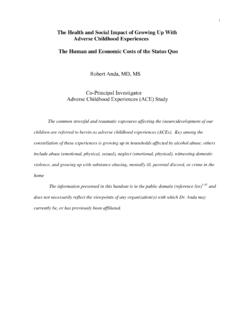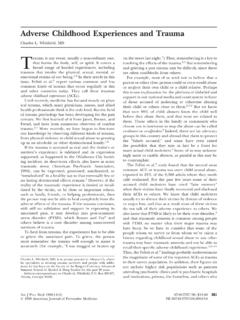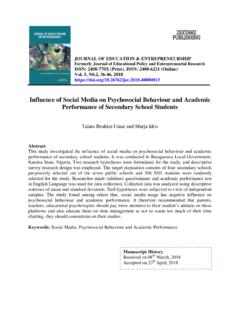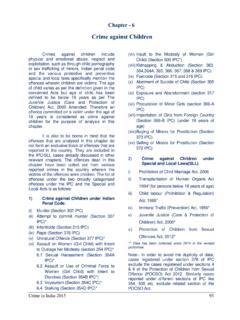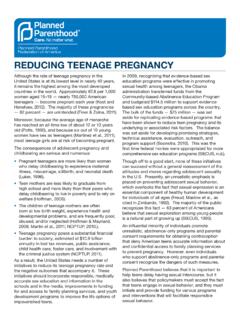Transcription of What Can Happen to Abused Children When They Grow Up – …
1 WCHAC-STATS What Can Happen to Abused Children When They Grow Up . If No One Notices, Listens or Helps? Some statistics from the Research For purposes of this document, abuse, and ,trauma, are defined as: interpersonal violence in the form of sexual abuse, physical abuse, severe neglect, loss, and /or the witnessing of violence. Prepared by The Office of Trauma Services, Maine Department of Behavioral and Developmental Services 40 State House Station, Augusta, ME 04333. Phone: 207 287-4250, TTY 207 287-2000, fax 207 287-7571. January, 2001. If no one notices, listens or helps, childhood abuse can lead in adult years to: SERIOUS MENTAL HEALTH PROBLEMS. The mental health system is filled with survivors of prolonged, repeated childhood trauma. 50 to 70% of all women and a substantial number of men treated in psychiatric settings have histories of sexual or physical abuse, or both. (Carmen et al, 1984; Bryer et al., 1987; Craine et al.)
2 , 1988). As high as 81% of men and women in psychiatric hospitals with a variety of major mental illness diagnoses, have experienced physical and/or sexual abuse. 67% of these men and women were Abused as Children . (Jacobson & Richardson, 1987). 74% of Maine?s Augusta Mental Health Institute patients, interviewed as class members, report histories of sexual and physical abuse. (Maine BDS, 1998). The majority of adults diagnosed with Borderline Personality Disorder (81%) or Dissociative Identity Disorder (90%) were sexually and/or physically Abused as Children . (Herman et al, 1989; Ross et al, 1990). Women molested as Children are four times more at risk for Major Depression as those with no such history. They are significantly more likely to develop bulimia and chronic PTSD. (Stein et al, 1988; Root & Fallon, 1988; Sloane, 1986; Craine, 1990). 1 of 5 3/6/2005 2:57 PM. WCHAC-STATS Childhood abuse can result in adult experience of shame, flashbacks, nightmares, severe anxiety, depression, alcohol and drug use, feelings of humiliation and unworthiness, ugliness and profound terror.
3 (Harris, 1997;. Rieker&Carmen, 1986; Herman, 1992; Janoff- Bulman & Frieze, 1983; van der Kolk, 1987; Brown & Finkelhor, 1986; Rimsza, 1988). Adults Abused during childhood are: - more than twice as likely to have at least one lifetime psychiatric diagnosis - almost three times as likely to have an affective disorder - almost three times as likely to have an anxiety disorder - almost 2 times as likely to have phobias - over ten times as likely to have a panic disorder - almost four times as likely to have an antisocial personality disorder (Stein et al, 1988). 97% of mentally ill homeless women have experienced severe physical and/or sexual abuse. 87%. experienced this abuse both as Children and as adults. (Goodman, Johnson, Dutton & Harris. (1997). SUICIDE AND SELF-INJURY. There is a highly significant relationship between childhood sexual abuse and various forms of self-harm later in life, suicide attempts, cutting, and self-starving particularly.)
4 (van der Kolk, et al, 1991). For adults and adolescents with childhood abuse histories, the risk of suicide is increased 4 to 12-fold. (Felitti, 1998). Most self-injurers have childhood histories of physical or sexual abuse. 40% of persons who self-injure are men. (Graff, 1967; Pattison, 1983; Briere, 1988). If no one notices, listens or helps, childhood abuse can lead in adult years to: ALCOHOL AND DRUG ABUSE. Nearly 90% of alcoholic women were sexually Abused as Children or suffered severe violence at the hands of a parent. (Miller, Downs, 1993). Up to two-thirds of both men and women in substance abuse treatment report childhood abuse or neglect. (SAMHSA, CSAT 2000). Teenagers with alcohol problems are 21 times more likely to have been sexually Abused than those without such problems. (Clark, 1997). 71% to 90% of adolescent and teenage girls and 23% to 42% of adolescent and teenage boys in a Maine inpatient substance-abuse treatment program reported histories of childhood-sexual abuse.
5 (Rohsenow, 1988). HMO Adult members who had experienced multiple childhood exposures to abuse and violence had a 4 to 12-fold increase risk of alcoholism and drug abuse, and a 2 to 4-fold increase in smoking. (Felitti et al, 1998). 2 of 5 3/6/2005 2:57 PM. WCHAC-STATS Adults Abused during childhood are more than twice as likely than those not Abused during childhood to have serious substance abuse problems. (Stein et al, 1988). 55% of Augusta Mental Health Institute class members with a dual diagnosis of mental illness & substance abuse report histories of physical and/or sexual abuse. (Maine BDS, 1998). SERIOUS MEDICAL PROBLEMS AND HEALTH RISKS. Medical impacts of childhood abuse include: Head trauma, brain injury, sexually transmitted diseases, unwanted pregnancy, HIV infection, physical disabilities (back injury, orthopedic, neck, etc.) chronic pelvic pain, headaches, stomach pain, nausea, sleep disturbance, eating disorder, asthma, shortness of breath, chronic muscle tension, muscle spasms, elevated blood pressure.
6 (Prescott, 1998; Cunningham, 1988, Morrison, 1989; Springs, 1992; Walker, 1988). Adults who had experienced multiple types of abuse and violence in childhood compared to those who had not, had a 2 to 4-fold increase in smoking, poor self-rated health, 50+ sexual intercourse partners, sexually transmitted disease, a higher rate of physical inactivity, and severe obesity. (Felitti, 1998). A major HMO study reports adverse childhood exposures showed a relationship with the presence of adult diseases, including ischemic heart disease, cancer, chronic lung disease, skeletal fractures, and liver disease. (Felitti, 1998). Research reveals severe and prolonged childhood sexual abuse to underlie damage to the brain structure, resulting in impaired memory, dissociation, and symptoms of PTSD. (Briere, 1997; van der Kolk, 1996; Perry, 1994). If no one notices, listens or helps, childhood abuse can lead in adult years to: DELINQUENCY, VIOLENCE AND CRIMINAL BEHAVIOR.
7 Reenactment of childhood victimization is the major cause of violence in our society. Numerous-studies have documented that most violent criminals were physically or sexually Abused as Children . (Groth, 1979; Seghorn et al, 1987). Over 95% of perpetrators who sexually abuse female Children and over 80% of those who abuse male Children , are men. Most of these men were Abused themselves in childhood. (Fergusson & Mullen, 1999). Children from violent homes are 24 times more likely to commit sexual assault than their counterparts from non-violent homes. (Dinzinger, 1996). Of 14 juveniles condemned to death for murder in the US in 1987, 12 had been brutally physically Abused and five had been sodomized by relatives as Children . (Lewis et al, 1998). A study of convicted killers reports suffered severe physical and emotional abuse and were sexually violated as Children . (Blake, 1995). 3 of 5 3/6/2005 2:57 PM. WCHAC-STATS 85% of boys and girls committed to the Maine Youth Center report a history of childhood trauma.
8 (MAYSI: Massachusetts Assessment Youth Screening Inventory Assessment. Sept. 1999). Over 75% of juvenile girls identified as delinquent by court have been sexually Abused . When they run away from the abuse at home, they are often labeled as delinquent. (Calhoun et al 1993). 80% of women in prison and jails have been victims of sexual and physical abuse. These women are far more likely to be Abused while in prison. (Smith, 1998). Without help, one-third of those Abused in childhood may abuse or neglect their own Children , perpetuating an intergenerational cycle of abuse. (Kaufman, 1987). DEVELOPMENTAL OR PHYSICAL DISABILITIES. Violence is a significant causal factor in 10% - 25% of all developmental disabilities. (Sobsey, 1994; Valenti-Hein & Schwartz, 1995). 3% - 6% of all Children will have some degree of permanent disability as a result of abuse. (Sobsey, 1994; Valenti-Hein & Schwartz, 1995). Between 20% - 50% of Abused Children suffer mild to severe brain damage.
9 (Rose & Hardman, 1981). If no one notices, listens or helps, childhood abuse can lead in adult years to: SEVERE SOCIAL PROBLEMS. Homelessness: 70% of women living on the streets or in shelters report abuse in childhood. Over 70% of girls on the streets have run away to flee violence in their homes. (Goodman, 1991; Chesney-Lind & Shelden, 1998). Prostitution: Victims of child sexual abuse are at high risk of becoming prostitutes in adolescence or as adults. More than 50% of prostitutes were sexually Abused as Children . (Silbert & Pines, 1981; Bagley & Young, 1987; Pithers). Poverty and Welfare: More than 40% of women on welfare with multiple persistent problems in leaving the welfare roles were sexually Abused as Children . (DeParle, 1999). 60% housed, low-income mothers on AFDC, experienced severe childhood physical abuse and 42% were sexually molested as Children . (Bassuk, 1997). Truancy, Running Away, Risky Sexual Behavior: 4 of 5 3/6/2005 2:57 PM.
10 WCHAC-STATS Childhood abuse has been correlated with increased adolescent and young adult truancy, running away, and risky sexual behavior. (Briere, 1992). REVICTIMIZATION. Predators look for weak or vulnerable people. Having been Abused as a child especially having been sexually Abused , makes one vulnerable to being revictimized. Women who are sexually Abused during childhood were times more likely to be revictimized as adults as women who were not sexually Abused . (Wyatt et al, 1992). 68% of women with childhood history of incest reported incidents of rape or attempted rape after age 14. compared to 38% of a random sample. (Russell, 1986). Girls who experience violence in childhood are three to four times as likely to be victims of rape. (Browne, 1992). Childhood sexual assaults are associated with increased risk of adult assaults of both a physical and sexual nature, whereas childhood physical assaults, by contrast, were not related to adult victimization experiences.
